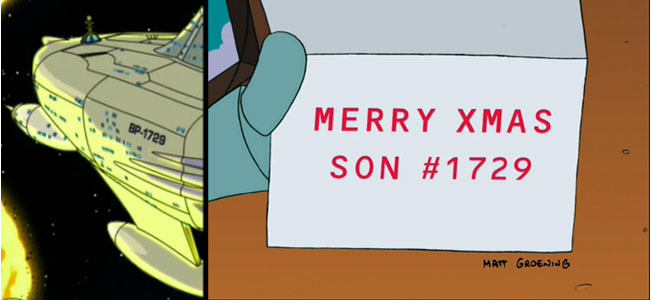第  個計程車數
個計程車數  是可以用
是可以用  種方式表示為正立方數之和的最小數。這些數字的名字來源於 哈代-拉馬努金數
種方式表示為正立方數之和的最小數。這些數字的名字來源於 哈代-拉馬努金數
這與 G. H. 哈代 (Hofstadter 1989, Kanigel 1991, Snow 1993) 講述的關於拉馬努金的故事有關。
1729 的這個性質在 2005 年的電影證明中被安東尼·霍普金斯扮演的角色羅伯特(有時是精神失常的數學家)提及。它也是動畫電視劇飛出個未來第二季 DVD 2ACV02 集(Greenwald;左圖)中出現的 Nimbus BP-1729 宇宙飛船的名稱的一部分,以及機器人角色本德的序列號,如聖誕賀卡在聖誕故事一集中所描繪的那樣(第 2 卷 DVD,Georgoulias et al. 2004;右圖)。
然而,早在 1657 年,F. de Bessy (Berndt and Bhargava 1993, Guy 1994) 就已經知道了這個性質。Leech (1957) 發現
Rosenstiel et al. (1991) 最近發現
Wilson (1999) 發現
因此,前幾個計程車數是 2, 1729, 87539319, 6963472309248, 48988659276962496, ... (OEIS A011541)。
第六個計程車數是
(Calude et al. 2003, Hollerbach 2008)。
Hardy 和 Wright (1979 年定理 412) 表明,這種和的數量可以任意大,但是,根據威爾遜的結果更新 Guy (1994) 的結果,對於六個或更多相等的和,最小的例子仍然未知。
Sloane 定義了一種略有不同的計程車數型別,即可以用兩種或多種方式表示為兩個立方和的數字,其中前幾個是 1729, 4104, 13832, 20683, 32832, 39312, 40033, 46683, 64232, ... (OEIS A001235)。
另請參見
Cabtaxi 數,
丟番圖方程——3 次冪,
哈代-拉馬努金數,
計程車度量
使用 探索
參考文獻
Berndt, B. C. and Bhargava, S. "Ramanujan--For Lowbrows." Am. Math. Monthly 100, 645-656, 1993.Butler, B. "Ramanujan Numbers and the Taxicab Problem." http://www.durangobill.com/Ramanujan.html.Calude,C. S.; Calude, E.; and Dinneen, M. J. "What Is the Value of Taxicab(6)?" J. Uni. Comp. Sci. 9, 1196-1203, 2003. http://www.cs.auckland.ac.nz/~cristian/taxicab.pdf.Georgoulias, T.; Greenwald, S. J.; and Wichterich, M. "Futurama  : Mathematics in the Year 3000." Math Horizons, 12-15, Apr. 2004.Greenwald, S. "Dr. Sarah's Futurama
: Mathematics in the Year 3000." Math Horizons, 12-15, Apr. 2004.Greenwald, S. "Dr. Sarah's Futurama  --Mathematics in the Year 3000." http://www.mathsci.appstate.edu/~sjg/futurama/.Guy, R. K. "Sums of Like Powers. Euler's Conjecture." §D1 in Unsolved Problems in Number Theory, 2nd ed. New York: Springer-Verlag, pp. 139-144, 1994.Hardy, G. H. Ramanujan: Twelve Lectures on Subjects Suggested by His Life and Work, 3rd ed. New York: Chelsea, pp. 12 and 68, 1999.Hardy, G. H. and Wright, E. M. An Introduction to the Theory of Numbers, 5th ed. Oxford, England: Clarendon Press, 1979.Hofstadter, D. R. Gödel, Escher, Bach: An Eternal Golden Braid. New York: Vintage Books, p. 564, 1989.Hollerbach, U. "The Sixth Taxicab Number Is 24153319581254312065344." Mar. 8, 2008. http://listserv.nodak.edu/cgi-bin/wa.exe?A2=ind0803&L=nmbrthry&T=0&F=&S=&P=1059.Kanigel, R. The Man Who Knew Infinity: A Life of the Genius Ramanujan. New York: Washington Square Press, p. 312, 1991.Leech, J. "Some Solutions of Diophantine Equations." Proc. Cambridge Phil. Soc. 53, 778-780, 1957.Meyrignac, J. "The Taxicab Problem." http://euler.free.fr/taxicab.htm.Plouffe, S. "Taxicab Numbers." http://pi.lacim.uqam.ca/eng/problem_en.html.Rosenstiel, E.; Dardis, J. A.; and Rosenstiel, C. R. "The Four Least Solutions in Distinct Positive Integers of the Diophantine Equation
--Mathematics in the Year 3000." http://www.mathsci.appstate.edu/~sjg/futurama/.Guy, R. K. "Sums of Like Powers. Euler's Conjecture." §D1 in Unsolved Problems in Number Theory, 2nd ed. New York: Springer-Verlag, pp. 139-144, 1994.Hardy, G. H. Ramanujan: Twelve Lectures on Subjects Suggested by His Life and Work, 3rd ed. New York: Chelsea, pp. 12 and 68, 1999.Hardy, G. H. and Wright, E. M. An Introduction to the Theory of Numbers, 5th ed. Oxford, England: Clarendon Press, 1979.Hofstadter, D. R. Gödel, Escher, Bach: An Eternal Golden Braid. New York: Vintage Books, p. 564, 1989.Hollerbach, U. "The Sixth Taxicab Number Is 24153319581254312065344." Mar. 8, 2008. http://listserv.nodak.edu/cgi-bin/wa.exe?A2=ind0803&L=nmbrthry&T=0&F=&S=&P=1059.Kanigel, R. The Man Who Knew Infinity: A Life of the Genius Ramanujan. New York: Washington Square Press, p. 312, 1991.Leech, J. "Some Solutions of Diophantine Equations." Proc. Cambridge Phil. Soc. 53, 778-780, 1957.Meyrignac, J. "The Taxicab Problem." http://euler.free.fr/taxicab.htm.Plouffe, S. "Taxicab Numbers." http://pi.lacim.uqam.ca/eng/problem_en.html.Rosenstiel, E.; Dardis, J. A.; and Rosenstiel, C. R. "The Four Least Solutions in Distinct Positive Integers of the Diophantine Equation  ." Bull. Inst. Math. Appl. 27, 155-157, 1991.Silverman, J. H. "Taxicabs and Sums of Two Cubes." Amer. Math. Monthly 100, 331-340, 1993.Sloane, N. J. A. Sequences A001235 and A011541 in "The On-Line Encyclopedia of Integer Sequences."Snow, C. P. Foreword to A Mathematician's Apology, reprinted with a foreword by C. P. Snow (by G. H. Hardy). New York: Cambridge University Press, p. 37, 1993.Wilson, D. W. "The Fifth Taxicab Number is 48988659276962496." J. Integer Sequences 2, #99.1.9, 1999.Wooley, T. D. "Sums of Two Cubes." Internat. Math. Res. Not. No. 4, 181-184, 1995.
." Bull. Inst. Math. Appl. 27, 155-157, 1991.Silverman, J. H. "Taxicabs and Sums of Two Cubes." Amer. Math. Monthly 100, 331-340, 1993.Sloane, N. J. A. Sequences A001235 and A011541 in "The On-Line Encyclopedia of Integer Sequences."Snow, C. P. Foreword to A Mathematician's Apology, reprinted with a foreword by C. P. Snow (by G. H. Hardy). New York: Cambridge University Press, p. 37, 1993.Wilson, D. W. "The Fifth Taxicab Number is 48988659276962496." J. Integer Sequences 2, #99.1.9, 1999.Wooley, T. D. "Sums of Two Cubes." Internat. Math. Res. Not. No. 4, 181-184, 1995.在 上引用
計程車數
請引用為
Weisstein, Eric W. "計程車數。" 來自 —— 資源。 https://mathworld.tw/TaxicabNumber.html
主題分類
個計程車數
是可以用
種方式表示為正立方數之和的最小數。這些數字的名字來源於 哈代-拉馬努金數
